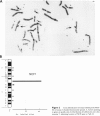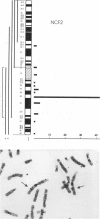Abstract
Chronic granulomatous disease (CGD) is a heterogeneous group of inherited disorders of impaired superoxide production in phagocytes. The most common X-linked recessive form involves the CYBB locus in band Xp21.1 that encodes the membrane-bound beta subunit of the cytochrome b558 complex. Two autosomal recessive forms of CGD result from defects in cytosolic components of the phagocyte NADPH oxidase system, p47phox (NCF1) and p67phox (NCF2). By using human cDNA probes we have mapped the genes for these proteins to chromosomal sites. The combined data from Southern analysis of somatic cell hybrid lines and chromosomal in situ hybridization localize NCF1 to 7q11.23 and NCF2 to band 1q25. The NCF1 localization corrects an erroneous preliminary assignment to chromosome 10. In the mouse, the locus corresponding to NCF2 (Ncf-2) was mapped with somatic cell hybrid panels and recombinant inbred strains to mouse chromosome 1 near Xmv-21 within a region of conserved homology with human chromosome 1 region q21-q32. A second site, probably a processed pseudogene, was identified on mouse chromosome 13.
Full text
PDF









Images in this article
Selected References
These references are in PubMed. This may not be the complete list of references from this article.
- Battat L., Francke U. Nsi I RFLP at the X-linked chronic granulomatous disease locus (CYBB). Nucleic Acids Res. 1989 May 11;17(9):3619–3619. doi: 10.1093/nar/17.9.3619. [DOI] [PMC free article] [PubMed] [Google Scholar]
- Bolscher B. G., van Zwieten R., Kramer I. M., Weening R. S., Verhoeven A. J., Roos D. A phosphoprotein of Mr 47,000, defective in autosomal chronic granulomatous disease, copurifies with one of two soluble components required for NADPH:O2 oxidoreductase activity in human neutrophils. J Clin Invest. 1989 Mar;83(3):757–763. doi: 10.1172/JCI113954. [DOI] [PMC free article] [PubMed] [Google Scholar]
- Caldwell S. E., McCall C. E., Hendricks C. L., Leone P. A., Bass D. A., McPhail L. C. Coregulation of NADPH oxidase activation and phosphorylation of a 48-kD protein(s) by a cytosolic factor defective in autosomal recessive chronic granulomatous disease. J Clin Invest. 1988 May;81(5):1485–1496. doi: 10.1172/JCI113480. [DOI] [PMC free article] [PubMed] [Google Scholar]
- Clark R. A., Malech H. L., Gallin J. I., Nunoi H., Volpp B. D., Pearson D. W., Nauseef W. M., Curnutte J. T. Genetic variants of chronic granulomatous disease: prevalence of deficiencies of two cytosolic components of the NADPH oxidase system. N Engl J Med. 1989 Sep 7;321(10):647–652. doi: 10.1056/NEJM198909073211005. [DOI] [PubMed] [Google Scholar]
- Curnutte J. T. Classification of chronic granulomatous disease. Hematol Oncol Clin North Am. 1988 Jun;2(2):241–252. [PubMed] [Google Scholar]
- Curnutte J. T., Scott P. J., Mayo L. A. Cytosolic components of the respiratory burst oxidase: resolution of four components, two of which are missing in complementing types of chronic granulomatous disease. Proc Natl Acad Sci U S A. 1989 Feb;86(3):825–829. doi: 10.1073/pnas.86.3.825. [DOI] [PMC free article] [PubMed] [Google Scholar]
- Dinauer M. C., Curnutte J. T., Rosen H., Orkin S. H. A missense mutation in the neutrophil cytochrome b heavy chain in cytochrome-positive X-linked chronic granulomatous disease. J Clin Invest. 1989 Dec;84(6):2012–2016. doi: 10.1172/JCI114393. [DOI] [PMC free article] [PubMed] [Google Scholar]
- Dinauer M. C., Orkin S. H., Brown R., Jesaitis A. J., Parkos C. A. The glycoprotein encoded by the X-linked chronic granulomatous disease locus is a component of the neutrophil cytochrome b complex. 1987 Jun 25-Jul 1Nature. 327(6124):717–720. doi: 10.1038/327717a0. [DOI] [PubMed] [Google Scholar]
- Francke U., Ochs H. D., de Martinville B., Giacalone J., Lindgren V., Distèche C., Pagon R. A., Hofker M. H., van Ommen G. J., Pearson P. L. Minor Xp21 chromosome deletion in a male associated with expression of Duchenne muscular dystrophy, chronic granulomatous disease, retinitis pigmentosa, and McLeod syndrome. Am J Hum Genet. 1985 Mar;37(2):250–267. [PMC free article] [PubMed] [Google Scholar]
- Francke U. Random X inactivation resulting in mosaic nullisomy of region Xp21.1----p21.3 associated with heterozygosity for ornithine transcarbamylase deficiency and for chronic granulomatous disease. Cytogenet Cell Genet. 1984;38(4):298–307. doi: 10.1159/000132078. [DOI] [PubMed] [Google Scholar]
- Francke U., Yang-Feng T. L., Brissenden J. E., Ullrich A. Chromosomal mapping of genes involved in growth control. Cold Spring Harb Symp Quant Biol. 1986;51(Pt 2):855–866. doi: 10.1101/sqb.1986.051.01.099. [DOI] [PubMed] [Google Scholar]
- Frankel W. N., Stoye J. P., Taylor B. A., Coffin J. M. Genetic analysis of endogenous xenotropic murine leukemia viruses: association with two common mouse mutations and the viral restriction locus Fv-1. J Virol. 1989 Apr;63(4):1763–1774. doi: 10.1128/jvi.63.4.1763-1774.1989. [DOI] [PMC free article] [PubMed] [Google Scholar]
- Hsieh C. L., Sturm R., Herr W., Francke U. The gene for the ubiquitous octamer-binding protein Oct-1 is on human chromosome 1, region cen-q32, and near Ly-22 and Ltw-4 on mouse chromosome 1. Genomics. 1990 Apr;6(4):666–672. doi: 10.1016/0888-7543(90)90502-l. [DOI] [PubMed] [Google Scholar]
- Hsieh C. L., Vogel U. S., Dixon R. A., Francke U. Chromosome localization and cDNA sequence of murine and human genes for ras p21 GTPase activating protein (GAP). Somat Cell Mol Genet. 1989 Nov;15(6):579–590. doi: 10.1007/BF01534919. [DOI] [PubMed] [Google Scholar]
- Joyner A. L., Lebo R. V., Kan Y. W., Tjian R., Cox D. R., Martin G. R. Comparative chromosome mapping of a conserved homoeo box region in mouse and human. Nature. 1985 Mar 14;314(6007):173–175. doi: 10.1038/314173a0. [DOI] [PubMed] [Google Scholar]
- Kramer I. M., van der Bend R. L., Verhoeven A. J., Roos D. The 47-kDa protein involved in the NADPH:O2 oxidoreductase activity of human neutrophils is phosphorylated by cyclic AMP-dependent protein kinase without induction of a respiratory burst. Biochim Biophys Acta. 1988 Sep 16;971(2):189–196. doi: 10.1016/0167-4889(88)90191-7. [DOI] [PubMed] [Google Scholar]
- Kruh G. D., King C. R., Kraus M. H., Popescu N. C., Amsbaugh S. C., McBride W. O., Aaronson S. A. A novel human gene closely related to the abl proto-oncogene. Science. 1986 Dec 19;234(4783):1545–1548. doi: 10.1126/science.3787260. [DOI] [PubMed] [Google Scholar]
- Lalley P. A., Davison M. T., Graves J. A., O'Brien S. J., Womack J. E., Roderick T. H., Creau-Goldberg N., Hillyard A. L., Doolittle D. P., Rogers J. A. Report of the committee on comparative mapping. Cytogenet Cell Genet. 1989;51(1-4):503–532. doi: 10.1159/000132806. [DOI] [PubMed] [Google Scholar]
- Leto T. L., Fortugno-Erikson D., Barton D., Yang-Feng T. L., Francke U., Harris A. S., Morrow J. S., Marchesi V. T., Benz E. J., Jr Comparison of nonerythroid alpha-spectrin genes reveals strict homology among diverse species. Mol Cell Biol. 1988 Jan;8(1):1–9. doi: 10.1128/mcb.8.1.1. [DOI] [PMC free article] [PubMed] [Google Scholar]
- Leto T. L., Lomax K. J., Volpp B. D., Nunoi H., Sechler J. M., Nauseef W. M., Clark R. A., Gallin J. I., Malech H. L. Cloning of a 67-kD neutrophil oxidase factor with similarity to a noncatalytic region of p60c-src. Science. 1990 May 11;248(4956):727–730. doi: 10.1126/science.1692159. [DOI] [PubMed] [Google Scholar]
- Lomax K. J., Leto T. L., Nunoi H., Gallin J. I., Malech H. L. Recombinant 47-kilodalton cytosol factor restores NADPH oxidase in chronic granulomatous disease. Science. 1989 Jul 28;245(4916):409–412. doi: 10.1126/science.2547247. [DOI] [PubMed] [Google Scholar]
- Mann K. G., Nesheim M. E., Church W. R., Haley P., Krishnaswamy S. Surface-dependent reactions of the vitamin K-dependent enzyme complexes. Blood. 1990 Jul 1;76(1):1–16. [PubMed] [Google Scholar]
- Münke M., Cox D. R., Jackson I. J., Hogan B. L., Francke U. The murine Hox-2 cluster of homeo box containing genes maps distal on chromosome 11 near the tail-short (Ts) locus. Cytogenet Cell Genet. 1986;42(4):236–240. doi: 10.1159/000132284. [DOI] [PubMed] [Google Scholar]
- Nunoi H., Rotrosen D., Gallin J. I., Malech H. L. Two forms of autosomal chronic granulomatous disease lack distinct neutrophil cytosol factors. Science. 1988 Dec 2;242(4883):1298–1301. doi: 10.1126/science.2848319. [DOI] [PubMed] [Google Scholar]
- Okamura N., Curnutte J. T., Roberts R. L., Babior B. M. Relationship of protein phosphorylation to the activation of the respiratory burst in human neutrophils. Defects in the phosphorylation of a group of closely related 48-kDa proteins in two forms of chronic granulomatous disease. J Biol Chem. 1988 May 15;263(14):6777–6782. [PubMed] [Google Scholar]
- Orkin S. H. Molecular genetics of chronic granulomatous disease. Annu Rev Immunol. 1989;7:277–307. doi: 10.1146/annurev.iy.07.040189.001425. [DOI] [PubMed] [Google Scholar]
- Parkos C. A., Allen R. A., Cochrane C. G., Jesaitis A. J. Purified cytochrome b from human granulocyte plasma membrane is comprised of two polypeptides with relative molecular weights of 91,000 and 22,000. J Clin Invest. 1987 Sep;80(3):732–742. doi: 10.1172/JCI113128. [DOI] [PMC free article] [PubMed] [Google Scholar]
- Parkos C. A., Dinauer M. C., Jesaitis A. J., Orkin S. H., Curnutte J. T. Absence of both the 91kD and 22kD subunits of human neutrophil cytochrome b in two genetic forms of chronic granulomatous disease. Blood. 1989 May 1;73(6):1416–1420. [PubMed] [Google Scholar]
- Parkos C. A., Dinauer M. C., Walker L. E., Allen R. A., Jesaitis A. J., Orkin S. H. Primary structure and unique expression of the 22-kilodalton light chain of human neutrophil cytochrome b. Proc Natl Acad Sci U S A. 1988 May;85(10):3319–3323. doi: 10.1073/pnas.85.10.3319. [DOI] [PMC free article] [PubMed] [Google Scholar]
- Royer-Pokora B., Kunkel L. M., Monaco A. P., Goff S. C., Newburger P. E., Baehner R. L., Cole F. S., Curnutte J. T., Orkin S. H. Cloning the gene for an inherited human disorder--chronic granulomatous disease--on the basis of its chromosomal location. Nature. 1986 Jul 3;322(6074):32–38. doi: 10.1038/322032a0. [DOI] [PubMed] [Google Scholar]
- Sechler J. M., Malech H. L., White C. J., Gallin J. I. Recombinant human interferon-gamma reconstitutes defective phagocyte function in patients with chronic granulomatous disease of childhood. Proc Natl Acad Sci U S A. 1988 Jul;85(13):4874–4878. doi: 10.1073/pnas.85.13.4874. [DOI] [PMC free article] [PubMed] [Google Scholar]
- Segal A. W., Cross A. R., Garcia R. C., Borregaard N., Valerius N. H., Soothill J. F., Jones O. T. Absence of cytochrome b-245 in chronic granulomatous disease. A multicenter European evaluation of its incidence and relevance. N Engl J Med. 1983 Feb 3;308(5):245–251. doi: 10.1056/NEJM198302033080503. [DOI] [PubMed] [Google Scholar]
- Segal A. W. Cytochrome b-245 and its involvement in the molecular pathology of chronic granulomatous disease. Hematol Oncol Clin North Am. 1988 Jun;2(2):213–223. [PubMed] [Google Scholar]
- Seldin M. F., Kruh G. D. Mapping of Abll within a conserved linkage group on distal mouse chromosome 1 syntenic with human chromosome 1 using an interspecific cross. Genomics. 1989 Feb;4(2):221–223. doi: 10.1016/0888-7543(89)90305-4. [DOI] [PubMed] [Google Scholar]
- Shephard E. A., Phillips I. R., Santisteban I., West L. F., Palmer C. N., Ashworth A., Povey S. Isolation of a human cytochrome P-450 reductase cDNA clone and localization of the corresponding gene to chromosome 7q11.2. Ann Hum Genet. 1989 Oct;53(Pt 4):291–301. doi: 10.1111/j.1469-1809.1989.tb01798.x. [DOI] [PubMed] [Google Scholar]
- Teahan C., Rowe P., Parker P., Totty N., Segal A. W. The X-linked chronic granulomatous disease gene codes for the beta-chain of cytochrome b-245. 1987 Jun 25-Jul 1Nature. 327(6124):720–721. doi: 10.1038/327720a0. [DOI] [PubMed] [Google Scholar]
- Volpp B. D., Nauseef W. M., Clark R. A. Two cytosolic neutrophil oxidase components absent in autosomal chronic granulomatous disease. Science. 1988 Dec 2;242(4883):1295–1297. doi: 10.1126/science.2848318. [DOI] [PubMed] [Google Scholar]
- Volpp B. D., Nauseef W. M., Donelson J. E., Moser D. R., Clark R. A. Cloning of the cDNA and functional expression of the 47-kilodalton cytosolic component of human neutrophil respiratory burst oxidase. Proc Natl Acad Sci U S A. 1989 Sep;86(18):7195–7199. doi: 10.1073/pnas.86.18.7195. [DOI] [PMC free article] [PubMed] [Google Scholar]
- Weening R. S., Corbeel L., de Boer M., Lutter R., van Zwieten R., Hamers M. N., Roos D. Cytochrome b deficiency in an autosomal form of chronic granulomatous disease. A third form of chronic granulomatous disease recognized by monocyte hybridization. J Clin Invest. 1985 Mar;75(3):915–920. doi: 10.1172/JCI111792. [DOI] [PMC free article] [PubMed] [Google Scholar]







